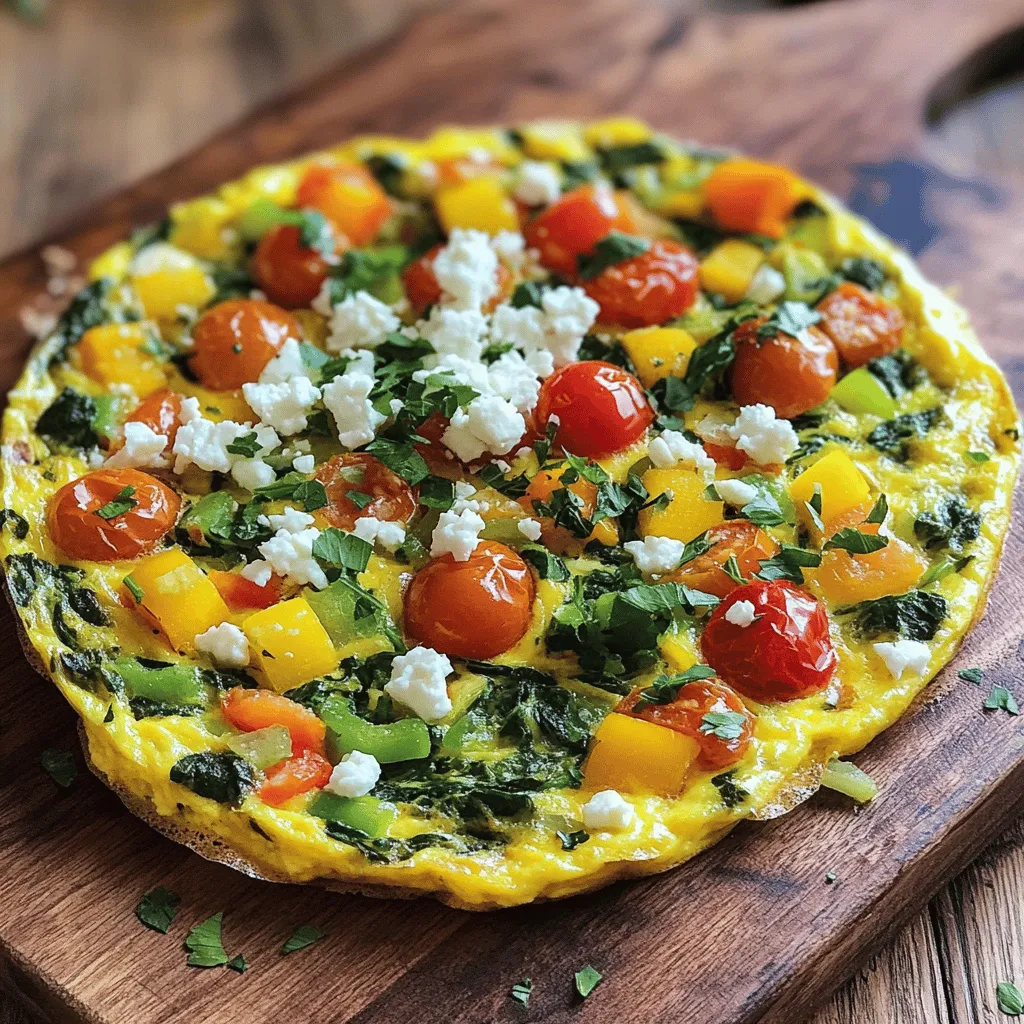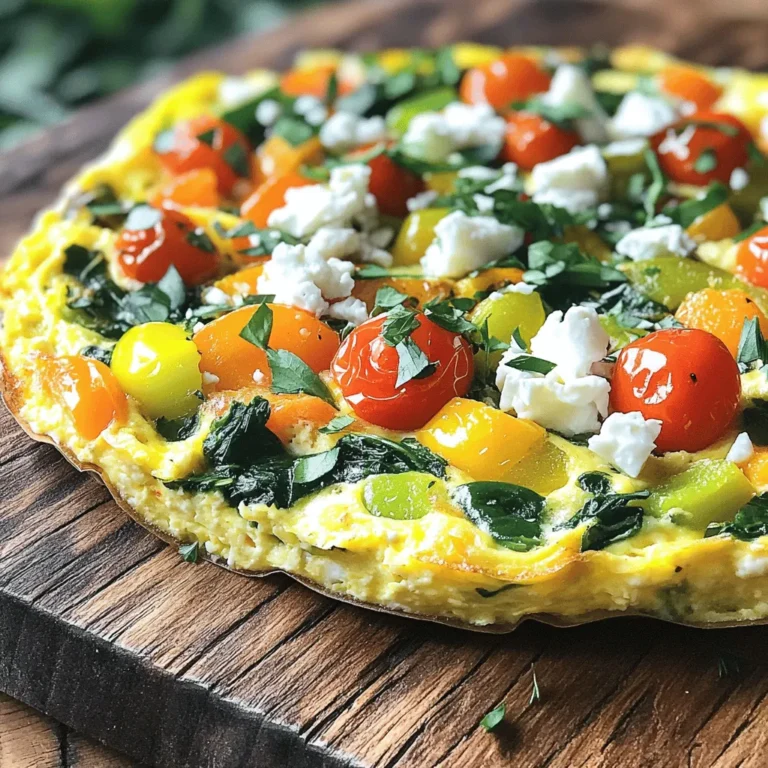Are you in the mood for a dish that’s both easy to make and packed with flavor? My Fluffy Vegetable Frittata is just what you need! This recipe is not only simple but also a fantastic way to use fresh veggies. With just a few key ingredients and step-by-step instructions, you’ll whip up a delicious meal that everyone will love. Let’s dive in and create this tasty treat together!
Ingredients
To make a fluffy vegetable frittata, you need the following:
– 6 large eggs
– 1/4 cup milk (or plant-based alternative)
– 1 cup fresh spinach, finely chopped
– 1/2 cup bell peppers, diced
– 1/2 cup cherry tomatoes, halved
– 1/4 cup red onion, finely chopped
– 1/2 cup zucchini, diced
– 1/2 teaspoon garlic powder
– 1/2 teaspoon salt
– 1/4 teaspoon freshly ground black pepper
– 1/4 teaspoon sweet paprika
– 1/4 cup feta cheese, crumbled (optional)
– 2 tablespoons olive oil
– Fresh herbs for garnish
These ingredients create a tasty and colorful dish. The eggs provide protein, while the veggies add fiber and vitamins. You can mix and match vegetables based on your taste. Try adding mushrooms or broccoli for a twist. The feta cheese adds a creamy touch, but feel free to leave it out if you prefer.
Step-by-Step Instructions
Preparation Steps
– Preheat oven to 375°F (190°C).
– In a large bowl, whisk together 6 eggs and 1/4 cup milk until smooth.
– Heat 2 tablespoons of olive oil in an oven-safe skillet. Sauté 1/4 cup finely chopped red onion for 2-3 minutes until soft.
Cooking Process
– Add 1/2 cup diced bell peppers, 1/2 cup diced zucchini, and 1 cup chopped spinach to the skillet. Cook for 3-4 minutes until vegetables are tender.
– Carefully pour the egg mixture over the vegetables. Add 1/2 cup halved cherry tomatoes and 1/4 cup crumbled feta cheese if using.
– Cook on low heat for about 5 minutes. Use a spatula to lift the edges, letting uncooked egg flow underneath.
Finishing Touches
– When the edges set and the center is slightly wobbly, transfer the skillet to the oven.
– Bake for 10-15 minutes until set and golden.
– Let the frittata cool for a few moments before slicing. Garnish with fresh herbs before serving.
Tips & Tricks
Achieving Fluffiness
To make your frittata fluffy, you must whisk the eggs well. This adds air and makes the texture light. Use room temperature eggs for the best results. Cold eggs can lead to a denser frittata. Avoid overcooking the frittata. Cook it just until the edges set, leaving the center slightly wobbly. This helps keep it fluffy and moist.
Flavor Enhancements
You can spice up your frittata with herbs like thyme or oregano. Fresh herbs add nice flavors. If you want a cheesy touch, try mozzarella or goat cheese instead of feta. You can also add leftover meats, like cooked ham or turkey. Extra veggies, like mushrooms or asparagus, work well too. They make the dish more colorful and tasty.
Presentation Suggestions
For serving, a cast-iron skillet looks rustic and appealing. It keeps the frittata warm longer. Garnish with fresh herbs, like parsley or basil, for a pop of color. A few extra cherry tomatoes add a nice touch too. Pair your frittata with a crisp side salad or slices of crusty bread. This creates a complete meal that looks inviting and delicious.

Variations
Different Vegetable Combinations
You can mix and match veggies in your frittata. Here are some tasty ideas:
– Broccoli and cheddar frittata: Use fresh broccoli and add sharp cheddar cheese for a rich flavor.
– Mushroom and spinach variation: Sauté mushrooms and spinach together for a savory twist.
– Seasonal vegetable frittata ideas: Use what’s fresh! In spring, try asparagus and peas. In fall, add butternut squash and kale.
Dietary Adaptations
You can easily adapt the frittata for different diets:
– Gluten-free adaptations: This recipe is naturally gluten-free. Just keep all ingredients gluten-free.
– Vegan versions of the frittata: Replace eggs with chickpea flour mixed with water. Add nutritional yeast for a cheesy taste.
– Using dairy-free cheese options: Try almond or cashew cheese to keep it dairy-free but tasty.
Cooking Methods
You can cook a frittata in several ways:
– Skillet vs. oven-only techniques: A skillet gives a nice crust. An oven can make it fluffier. You can choose what you like best!
– Instant pot or pressure cooker variations: Use the Instant Pot for quick cooking. Just set it for 10 minutes on high.
– Air-frying the frittata: An air fryer can create a perfect crust. Set it at 350°F for about 10-12 minutes.
These variations let you enjoy the fluffy vegetable frittata in many fun ways.
Storage Info
Refrigeration Guidelines
To store leftover frittata, let it cool first. Wrap it tightly in plastic wrap or foil. You can also use an airtight container. This keeps it fresh for up to 3 days.
Reheating Tips
For reheating, the oven works best. Preheat it to 350°F (175°C). Place the frittata on a baking sheet and cover it with foil. Bake for about 10-15 minutes. This helps keep it fluffy. You can also use the microwave. Heat it in 30-second intervals. Check to see if it’s warm throughout.
Freezing Instructions
Yes, you can freeze frittata! Cut it into slices before freezing. Wrap each slice in foil or plastic wrap. Place them in a freezer-safe bag. This way, they stay fresh for up to 2 months. To thaw, place it in the fridge overnight. Reheat it in the oven or microwave as mentioned before. Enjoy your frittata later with great taste!
FAQs
Common Questions
How to know when a frittata is done?
You can tell a frittata is done when the edges are set and the center is slightly jiggly. It should look firm and lightly golden on top. Use a toothpick to check; it should come out clean when inserted in the center.
Can I add different herbs?
Yes, you can add any herbs you like! Fresh basil, parsley, or dill work well. Just chop them finely and mix them into the egg mixture before you pour it into the skillet.
What if I don’t have an oven-safe skillet?
If you lack an oven-safe skillet, use a regular skillet. Cook the frittata on the stove until the edges set. Then, transfer the mixture to a baking dish to finish cooking in the oven.
Troubleshooting
What to do if the frittata is soggy?
If your frittata turns out soggy, it may have too much liquid. Next time, drain excess moisture from vegetables before adding them. You can also cook it longer on low heat before transferring to the oven.
Fixing a dry frittata
If your frittata is dry, it likely overcooked. To fix this, serve it with a dollop of yogurt or a drizzle of olive oil. This will add moisture and improve the flavor.
Preventing sticking issues in the skillet
To avoid sticking, use enough oil and preheat the skillet well. You can also line the skillet with parchment paper. This helps in easy removal and keeps the frittata intact.
Nutritional Information
Caloric content of the frittata
A serving of this frittata has about 200 calories. This can vary based on the cheese and oil you use.
Protein and nutrient breakdown
Each serving offers about 12 grams of protein, thanks to the eggs. You also get vitamins from the veggies, like A and C.
Gluten-free and vegetarian status
This frittata is naturally gluten-free and vegetarian. You can enjoy it without any dietary concerns. If you want to add meat, that’s an option too!
This blog post covered how to make a tasty frittata with simple steps and fresh ingredients. You learned about the key ingredients, step-by-step cooking, and tips for the best results. We explored variations, storage, and common questions to enhance your cooking skills.
Remember, making a frittata can be fun and flexible. Enjoy experimenting with different veggies and flavors. Now, grab your ingredients and start cooking! A delicious meal awaits you.


